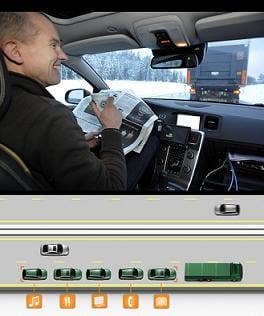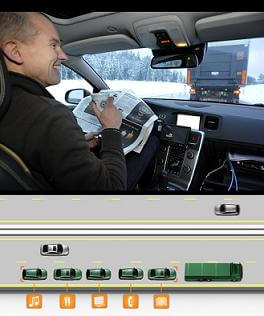Automated Car Convoys Pass First Test in Sweden (video)

Share
Not sure if you'd trust a computer to drive your car? Europe has an automated alternative that may suit you better. The SAfe Road TRains for the Envrionment project (SARTRE) is developing a convoy system that would slave a string of cars to the directions of the professional driver leading the pack. The road-train conductor drives, everyone else relaxes in their cabin as automated systems maintain the correct speed and distance from the leader. These packs of vehicles would travel down the highway at 55+ mph (90 km/h). Such car platoons would supposedly cut down on congestion, improve safety, and reduce environmental impact by increasing fuel efficiency. SARTRE recently had its first real world test of its prototype system on a Volvo track in Sweden. The test used a leading truck and just one trailing car, but watching even this mini-platoon of vehicles in action was pretty exciting. You can see highlights of the prototype's first run in the video below, followed by a lengthier video introduction to the project. If/when we adopt the concept of a car platoon, we'll be much closer to dreams of roads populated by fully automated cars. Yet there are the same social/legal battles associated with both. SARTRE thinks its technical systems will be street ready in a few years but anticipates a much longer legislative battle before road trains could be adopted. I totally agree.
From the outside, the SARTE prototype convoy just looks like some idiot is following a truck too closely. The trick is that the 'idiot' is actually a computer. In the trailing vehicle, a computer outfitted with range and IMU sensors maintains a set distance from the lead car. Communication between the vehicles let's the rear auto know how to react to changing conditions with the foresight/professional experience of the lead driver. That comm system is RF for now, but SARTRE is planning a 3G backup as well. As you can see in the video, the man in the trailing vehicle really doesn't have to do much. Just sit and relax while the automated systems and the lead driver handle all the hard work.
The following eight minute video was produced before the prototype test drive, but it covers the project in greater detail. Towards the second half you'll see reactions from average people when introduced to the road train concept.
The SARTRE system works pretty well in the prototype, and I think the general concept has merit. SARTRE claims that 80% of traffic accidents are due to driver error. Using a single professional driver could theoretically curb that significantly, and save lives in the process. The next step will be to pick up speed, narrow the separation distance, and add more cars. Considering what we've seen in other automated vehicle enterprises, I have little doubt that SARTRE will overcome these technical hurdles in the years ahead, and could have a full sized working system soon. But that won't really matter.
I said it earlier when I discussed the Google robot car, and I'm going to say again here: the biggest threat to automated driving isn't engineering problems, it's public perception. SARTRE seems to agree. From their press release:
The technology development is well underway and can most likely go into production in a few years time. What may take substantially longer are the public acceptance and the legislation where 25 EU governments must pass similar laws.
Social/legal concerns are simply too probable to ignore. In the EU there would be 25+ national governments that would need to review and revise the SARTRE system before passing legislation to allow it on the road. Each, I'm sure, would find a different part of the plan to critique. And there are reasonable critiques:
Entering and exiting the convoy could be dangerous, as there will be a necessary transition from automated to human driving.
Be Part of the Future
Sign up to receive top stories about groundbreaking technologies and visionary thinkers from SingularityHub.


Drivers in the convoy may insist upon having override controls to their vehicles, yet they will lack sufficient time to react considering the short spacing between vehicles and the high speeds.
Large convoys could be a difficult obstacle to non-convoyed vehicles on highways.
Who pays/regulates/organizes the lead drivers, especially across country lines?
The list goes on. None of these are unsurmountable hurdles for SARTRE to clear, but each will provide an opportunity for a bureaucratic entity to stall or restrict SARTRE adoption. I think that at least some of the public will support such cautious regulation. After all, trusting your car and life to an automated system is a scary idea to most people. Even with a human at the lead, there's still going to be fear.
It may be prescient that they named the project SARTRE because it could induce existential crises in the public. Changing to an automated driver system (or half automated as the case may be) will probably save lives, but we will have a hard time relinquishing life and death decisions to a computer. Especially when we know that it can't possibly work perfectly.
Despite the fact that they could be headed into a social/legal quagmire, SARTRE is pushing ahead. They've now passed their second milestone: a working prototype. With advances in the system they'll be able demonstrate improvement in environmental impact, safety, and highway congestion (another milestone). After that (or concurrently), SARTRE will endeavor to create/support new business models that will encourage the adoption of their system in the EU. There are obvious money making opportunities in such a new system, and considering the conveniences that SARTRE has to offer, I'm sure there will be many customers willing to overcome their fear so that they can read while 'driving'.
So, as tumultuous as the near future may look for SARTRE I think it's a reasonable step towards fully automated highways and therefore has a good chance of seeing some use. Especially if it is adopted/adapted by nations with more authoritarian leanings. China, I'm looking at you here. Goodness knows you have the traffic problems to generate support for the idea.
We might see road trains first, or we might skip directly to fully automated cars, but I'm increasingly of the opinion that the first nation to enjoy such wondrous achievements won't be the one that builds the technology earliest, it will be the nation that conquers the social and legal barriers quickest.
May the most open-minded country win.
[image credits: Volvo]
[video credits: Volvo via HighGearMediaVideos and AutomotiveTv]
[source: SARTRE, Volvo]
Related Articles

These Robots Are the Size of Single Cells and Cost Just a Penny Apiece

In Wild Experiment, Surgeon Uses Robot to Remove Blood Clot in Brain 4,000 Miles Away

A Squishy New Robotic ‘Eye’ Automatically Focuses Like Our Own
What we’re reading
